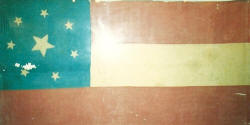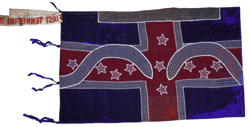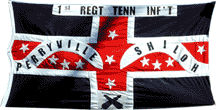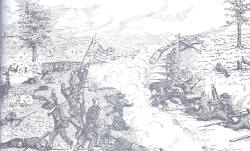|

Courtesy of the Battle
of Franklin Trust
|
This flag was made by local Franklin citizens
Elizabeth Wells, Fannie Wells, Actava? Courtney, Herrittice? Short in
April/May 1861 and presented to the Williamson Grays during a barbeque
at McGavock Grove by the Ladies of Franklin on May 10, 1861. The
flag was sent back to Franklin because the regiment chose to carry the
Rock City Guards flag (pictured below) after reaching Virginia.
Private James McEwen was discharged in 1861 and returned the flag and
buried it in a bottle until the war ended. It was donated to the
Carter House museum and is currently on display there. |

Courtesy of the Tennessee State
Museum |
This flag originally belonged to the Rock City
Guards from Nashville. It was captured in an ambush during the
Cheat Mountain Campaign on September 12, 1861. The star outside of
the circle has several different theories behind it. One is
representing Tennessee ascending into the Confederacy. Another is
perhaps three more stars were meant to go in the other corners as other
states seceded. The dimensions of the flag measure 35.5" x
83". It is made of linen, wool, cotton, and silk. Currently held at
the Tennessee State Museum. On their official record of the flag
it describes the flag as:
"Confederate Flag; blue field in upper staff
corner with 9 large white stars, 8 in a circle and 1 outside the circle;
faded red stripes at top and bottom with white stripe between lower red
stripe made in two pieces; two large bloodstains, one at center, one at
outer edge; several smaller bloodstains; numerous bullet & moth
holes overall; starred edge of flag has rope with tassels and red &
blue ribbons at each end.
It was captured by Capt. Chauncey of the 13th
Indiana Infantry and donated to the state of Tennessee by Chauncey's
granddaughter, Mrs. Franklin C. Goode, from Chattanooga, TN on March 13,
1982.
|

Courtesy of the Tennessee State Museum
|
Despite popular belief this flag
in all likelihood does not belong to the 1st Tennessee. While it
was captured by the 1st Wisconsin it is believed to have belonged to the
27th Tennessee and mistaken in identity after the battle by Federal
troops. After the war during a reunion of the 1st Tennessee a
member of the 1st Wisconsin sent a letter stating ownership of the flag
and his willingness to allow the regiment to borrow it for their
reunion. Members of the regiment responded that they never lost
their Polk Corps flag. There are no accounts from any soldiers in
the regiment saying their flag was lost in the battle.
Captain Bailey P. Steele, wounded in
the thigh at the Battle of Perryville, of Company B of the 1st Tennessee
recalls in a newspaper article in 1908 referring to losing the flag at
Perryville, "I have never believed that our battle flag was lost on that
occasion, or in any other battle during the war until the regiment
surrendered in April 1865....I have never been able to see any possible
chance for the enemy to have captured the flag of the First."
|


Courtesy of the Tennessee State Museum
|
The exact date of this flag's arrival to the
regiment is unknown. It is possible this was the original Polk
Corps flag they received upon becoming attached before Shiloh, and then
altered after the battle of Perryville later that year. The flag
is made of wool bunting and the two white "waves" carried the honors
Shiloh and Perryville. On the red cross in the bottom center
contained a set of crossed cannons. It was painted on a white block
and sewn to the flag. A star is believed to be missing on the
extreme right side of the flag above the wave. The white banner
across the top containing the regimental name measures 3". The
lettering on the banner was painted on black with a goldish outline around
the lettering. It was attached to the pole using four tie
strings. The dimensions of the flag are 28" x 46". A
streamer is attached to the flag with "FIRST TENNESSEE REGIMENT INFT"
painted on with red lettering. The bottom picture shows what it
most likely looked like during its use. This flag is currently at
the Tennessee State Museum. It was retired in early 1864 because
of General Johnston's order to revert the army to the St. Andrews Cross
pattern. |
 |
This flag was carried for the rest of the
war. Carrying the honors of Murfreesboro, Perryville, and
Shiloh. Still retaining the cross cannons at the bottom. The
only image of the flag available is from a sketch of the regiment
fighting at Kennesaw Mountain drawn by a participant. When the
regiment surrendered at Greensboro, NC it also surrendered this
flag. It was described as: "so bullet riddled and torn that it was
but a few blue and red shreds." Its whereabouts now are
unknown. Having been through the Atlanta Campaign, 1864 Tennessee
Campaign, and N.C. Campaign. There probably was not much to
save. |





